Cecil was born on 26 February 1891 in Saxlingham Nethergate. His parents were Benjamin and Margaret (nee Baldwin) English who lived at and ran the Queen Adelaide Public House on Church Hill, Saxlingham Nethergate. Before their marriage in 1882 both had lived and worked in Saxlingham. Benjamin had worked on his father’s farm in Pitts Hill and Margaret had been an assistant teacher at the local school.
They had nine children
Ada Bessie born 1883
Jessie Charlotte born 1885
Annie Maggie born 1886
Bertie born 1888
Fanny Ethel born 1889
Cecil Benjamin born 1891
Elsie Hannah Victoria born 1893
Clarence Evelyn born 1895
Lilian Elizabeth born 1897
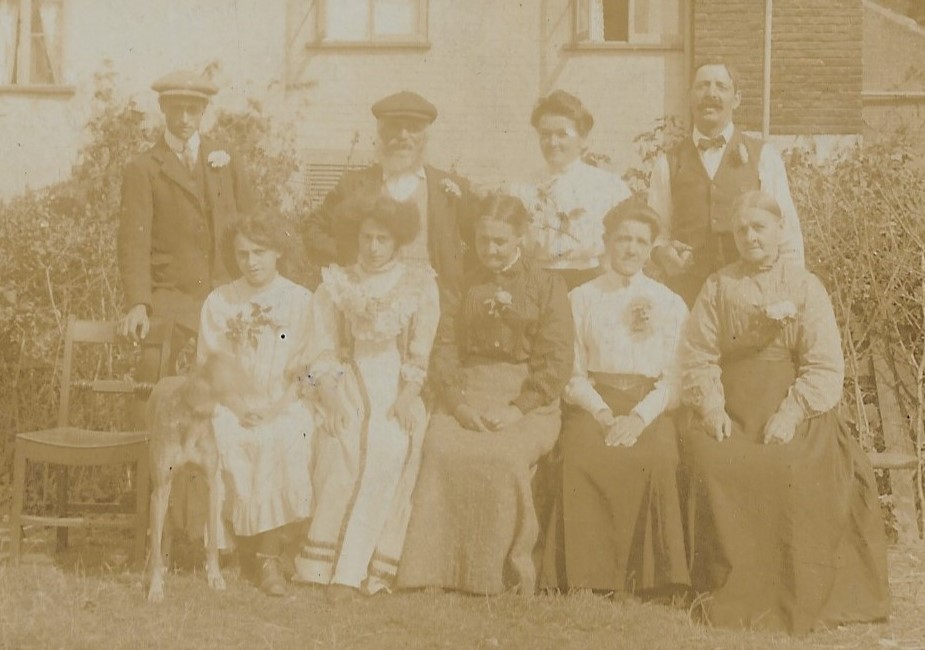
Family Group at a wedding. Benjamin is standing at the back with a beard. Margaret is sitting in the centre.
Cecil was baptised in St. Mary’s Church, Saxlingham Nethergate on 7 June 1891.
He started at Saxlingham Church School on 10 June 1895 aged 4 years.
In 1911 Cecil was working as a waggoner on a farm. He was still living at home with five of his siblings. Bertie was working as a butcher, Clarence was a farm labourer, Elsie was a housemaid, Fanny a dressmaker and Lilian was still at school. His eldest sister Ada was a barmaid at the White Hart Inn in Hopton, Jessie was an upper housemaid in a residential school in Hendon and Annie was working for the GPO as a telegraph clerk in Horsey Post Office.
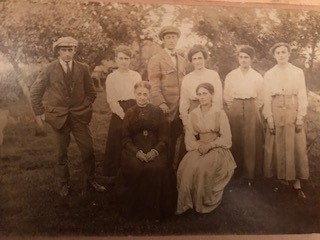
Margaret English and some of her family. Cecil is standing in the middle of the photograph, Clarence, (known as Tom) his brother, is on the left.
In 1913 his brother Bertie emigrated to Canada. He enlisted in the Canadian Infantry and died of wounds in France on 1 October 1918.
When Cecil enlisted in the Norfolk Regiment he gave his occupation as a farmer. He enlisted into the Norfolk Yeomanry on 21 September 1914. His service number was 1723. He gave his next of kin as his mother Margaret English of Queen Adelaide Tavern as his father had died in March 1913.
He was 22 years and 6 months old, was five feet nine and half inches tall, weighed 127 lbs and had a 35 inch ch
He went for training with C Company, Norfolk Regiment to Shoreham, Sussex and sent a postcard with his photograph on the front to Harriet Ladbroke, who was his girlfriend. She lived in Hardwick, where her father was a farmer.
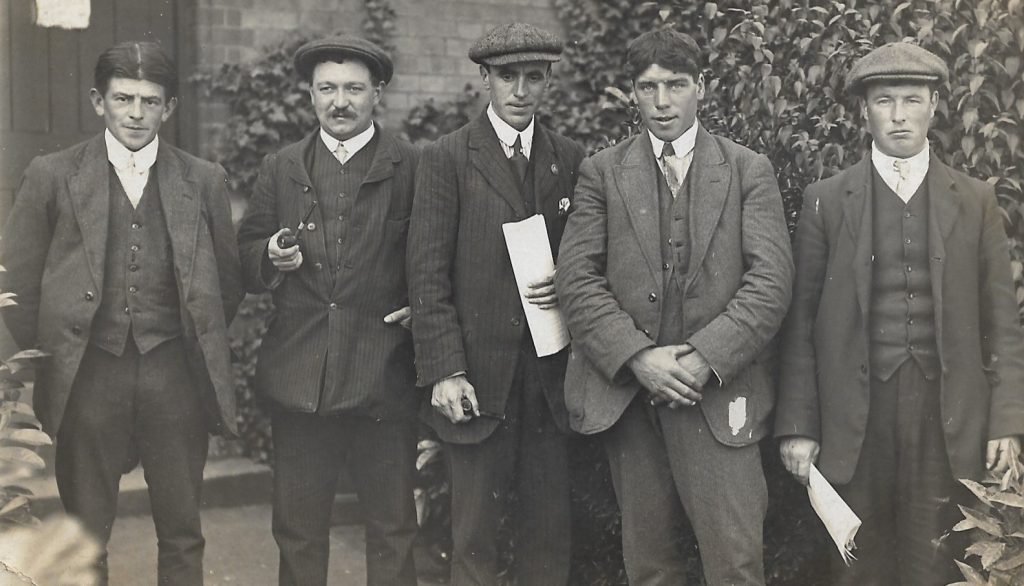
Postcard sent from Shoreham, Cecil is in the centre of the photograph
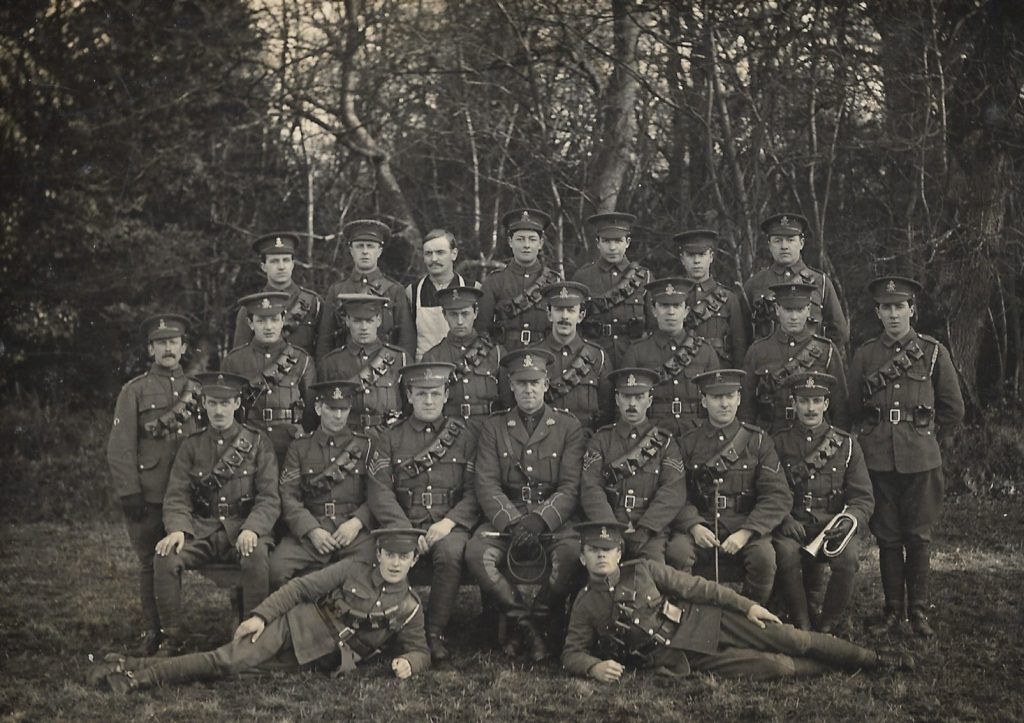
Norfolk Yeomanry Regiment. Cecil is standing, second row from the back, 4th from the left. ( In front of the man in the apron)
He was promoted to Lance Corporal on 1 March 1915 and then to Corporal on 2 June 1915.

Cecil in uniform when promoted to Corporal
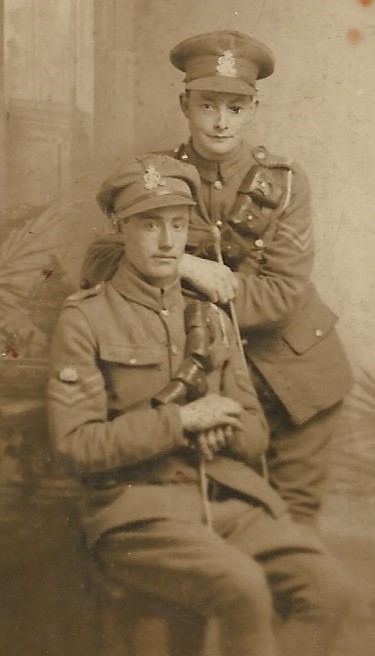
Cecil and friend after being promoted
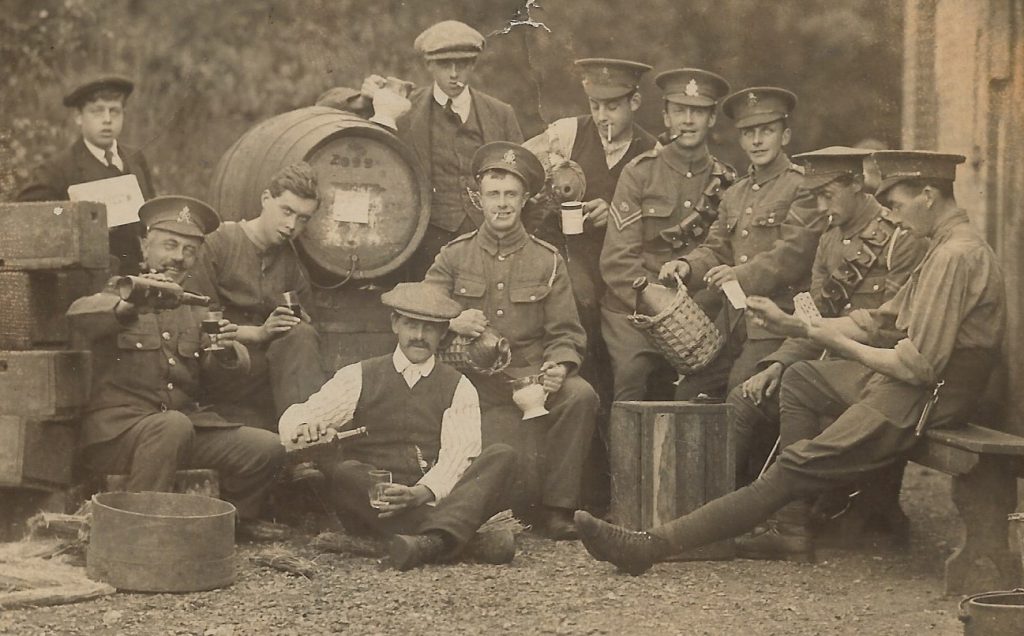
Cecil is second from the right in the photograph, playing cards and with a cigarette in his mouth. It may be outside the Queen Adelaide, taken before September 1916.
He transferred to the Army Cyclist Corps, service number 12715, on 7 September 1916 and was posted to Salonika (Thessaloniki, now Greece). He sailed from Devonport on 15 September 1916 on HMT Caledonia arriving in Salonika on 30 September 1916. (Also on the ship and in the same Corps was Frederick Robert Back, who is remembered on the Roll of Honour in Saxlingham Church. Two of Frederick’s sisters lived in the village and worked at the Bakery)
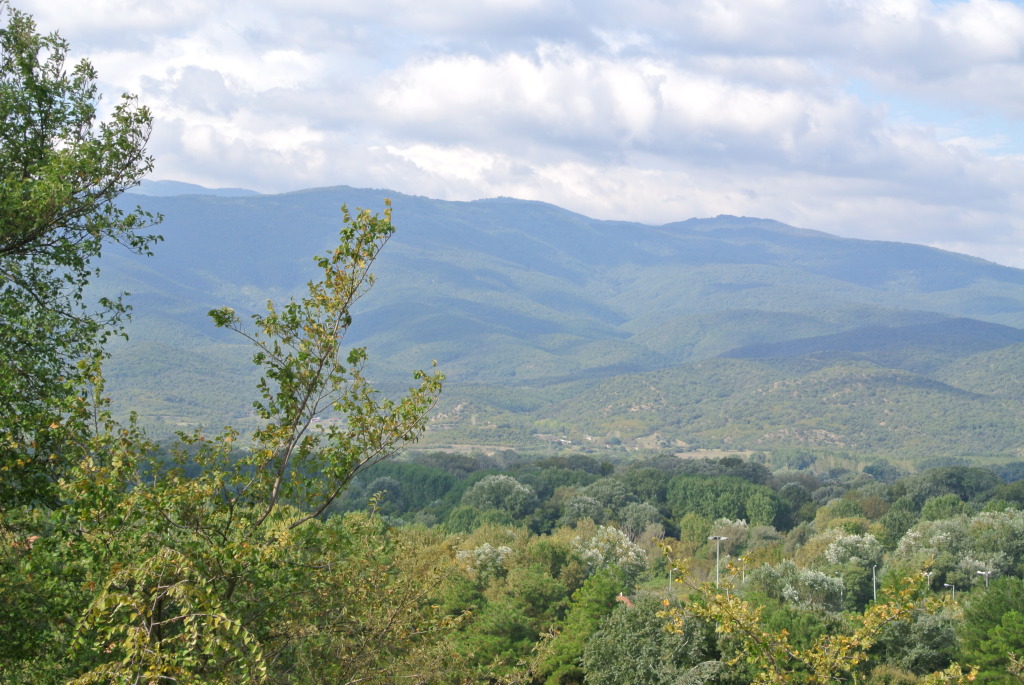
Cecil was posted to 12th Army Cyclist Corps on 5 December 1916
The use of cycles in the army had begun in 1880s and by the start of the war several territorial forces had units of cyclists. Cycles were seen as being quieter and easier to look after than horses. Their use for reconnaissance and communication was recognised. In 1915 the Army Cyclist Corps was founded. It incorporated existing units but also took men from second line yeomanry regiments. The cyclists were considered to be mounted infantry men with the ability to approach the enemy quietly and quickly. Their cycle was designed to enable the rider to travel as a self-contained fighting unit. It carried their rifle, cape and groundsheet. Their personal kit and rations were carried in a small kitbag behind the seat and an emergency tool kit hung from the crossbar
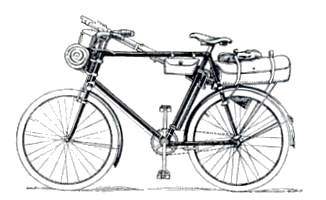
New rules and regulations had to be set up for the use of cycles; manuals were produced that described how cyclists had to stand when saluting officers etc. They were expected to travel between eight and ten miles an hour when in a group and not travel more than fifty miles in a day. In reality they were rarely used as a fighting force and they found it difficult on rough terrain and on muddy roads. In the Salonika area they were used for communication and for patrolling some of the villages outside of the main city. After the end of the war the Army Cyclist Corps was disbanded.
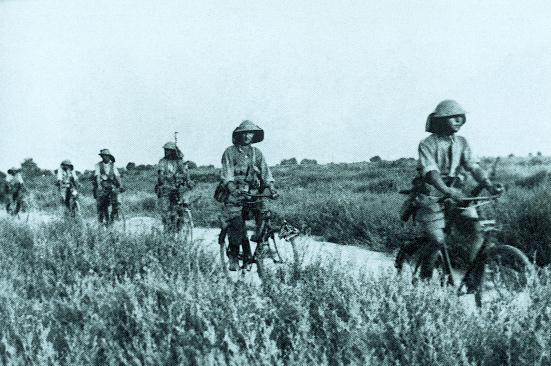
In March 1917 Cecil became ill and was admitted to 42nd General Hospital
where he was diagnosed as having myalgia ( muscle pain). This can be caused by a virus or strain. He remained in hospital for about three weeks before returning to his regiment.
On 11 October 1917 he was admitted to 60th General Hospital with a fever and stayed there until 17 November 1917. This was probably an attack of malaria though he stated that he had suffered from malaria from May 1917.

The aim of the campaign in this area was to help the Serbs fight against the German and Bulgarian armies. In the summer it was the area in Europe which had the worst problem with malaria. This was recognised early in the campaign and nets, cream and quinine were asked for but not received in the quantities required. The war in France and Flanders was considered to be of more importance. The troops were not adequately protected against malaria until the spring of 1917. Malaria and diseases, like dysentery and trench foot caused more casualties in this region than battle injuries. The men did eventually receive quinine but during the campaign 162,517 men contracted malaria. Many had repeated bouts of the disease, which left them thin, weak and often depressed. As a result of the war ten thousand men who fought in this area died from malaria.
On 19 October 1918 he was taken to 28th Casualty Clearing Station as being ill and suffering from anaemia.
From the location of the Casualty Clearing Station Cecil’s unit had beeninvolved in the Battle of Dorian. The war in this area ended on 30th September 1918 but transportation of the sick and wounded was difficult because of the terrain; the roads were bad and many of the bridges had been destroyed. The patients were transported to a rail head and then by train.
He was transferred by ambulance train to 28th General Hospital on 22 October 1918 The hospital was situated next to a rail terminus.
On 26 October 1918 a telegram was sent to the War Office in London saying that he was dangerously ill with malaria.
Frederick Back who was also in the Cycling Corps was in the same hospital at the same time. It is thought that he had suffered from gas poisoning and he died there on 26 October from pneumonia.
On 2 November it was recorded that Cecil was still dangerously ill but progressing favourably.
On 30 December 1918 he was transferred to the Hospital Ship, HMHS Gloucester Castle in Salonika. This ship arrived in Marseilles, France on 6 January 1919 and he was taken by Ambulance train to Le Havre arriving there on 9 January 1919. He was transferred to HM Ambulance Transport Kashmir and Aberdonian. (For more information about Ambulance trains see the entry for Leslie Barnabas Brighton)
He was taken to the 2nd Western General Hospital in Manchester where he stayed for 58 days leaving on 8 March 1919.
Records from the Military Hospitals state that at the time of transfer to the ship he was 25 years old and had been in the army for four years and one month. He had been with the field force for two years and one month and had malaria.
He applied for a pension as he was still debilitated from the malaria and was granted a pension of 6 shillings a week for six months from 7 April till 7 October 1919. He left the army on 6 April 1919. In the paperwork when he applied for a pension he is described as being intelligent, very reliable and his sobriety was very good.
In 1920 he married Harriet E Ladbroke, born 14 September 1892 in Swardeston. She came from Hardwick, Shelton where her family had a farm. They had seven children
Arthur James Benjamin born 9 July 1921
Jean born 27 July 1923
Peter born 11 May 1925
Peggy born 5 August 1927
Twins John and Nancy born 2 May 1930
Pauline born 18 December 1934
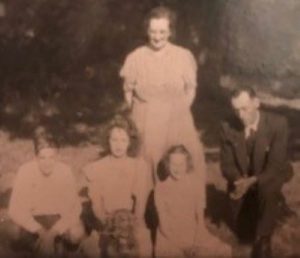
Cecil with Harriet and some of his children
In 1939 the family were living at Harris Green, Hardwick, Shelton, Norfolk and Cecil was a farm worker. Also living at home was Arthur who was a tool maker turner and machinist apprentice, John who was still at school and three other children whose names were withheld.
Cecil died in December 1951 aged 60 years old and is buried in St. Mary’s Churchyard, Shelton.
He suffered from ill health throughout his life. According to his family his early death was due to his having being gassed during the war. He never talked to his children about the part he played in the war or about the malaria.
Acknowledgements
England & Wales, Birth, marriage, death index 1837-2005
UK Census Collection
British Army Medal Roll Index cards, 1914-1920
1939 Register- www.findmypast.co.uk
Norfolk Electoral Rolls-Southern Division Saxlingham Nethergate and Thorpe, (Absent Voters Lists 1918-1920)
British Army Service Records
British Army Pension Records 1914-1920
Norfolk, Church of England Diocesan Baptismal Records, Saxlingham Nethergate.
Military Hospitals, Admissions and Discharge Registers WW1 www.forces-war-records.co.uk
Saxlingham Church School Log Book, Norfolk Record Office
Photograph of Army Cyclists- National Army Museum
www.25thlondon.com/cycleinwarfare.htm
www.salonikacampaignsociety.org.uk
It’s a long way to Salonika. www.historyireland.com
Photograph of 60th General Hospital. State Library of Western Australia
J Patrick – Surgical Service of the Salonika Army
Thanks to Pauline, his daughter, and Michelle Colman his granddaughter for family photographs.
Photograph of Northern Greece- Jeff Fox
If anyone has any photographs or information about this person please contact me. Email jan@janmfox.co.uk
